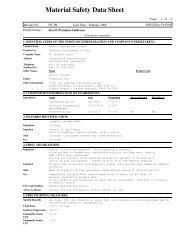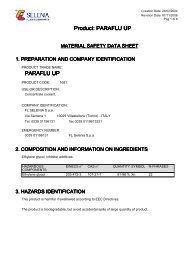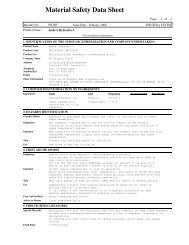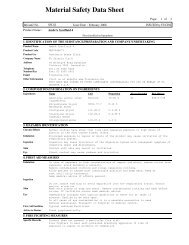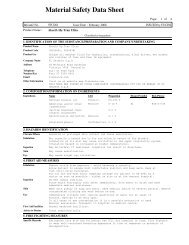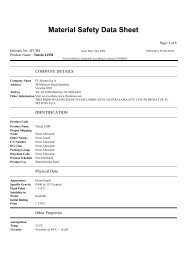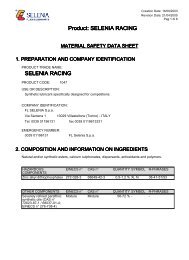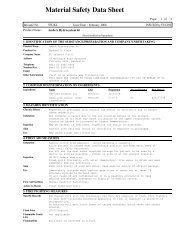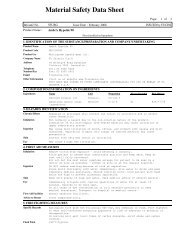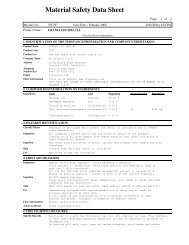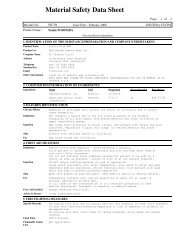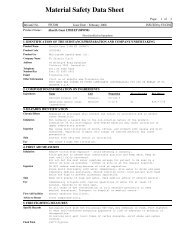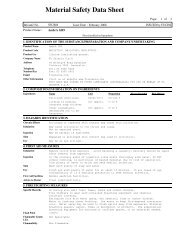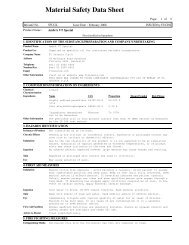Akcela Transaxle - FL Selenia
Akcela Transaxle - FL Selenia
Akcela Transaxle - FL Selenia
You also want an ePaper? Increase the reach of your titles
YUMPU automatically turns print PDFs into web optimized ePapers that Google loves.
Material Safety Data Sheet<br />
Page: 2 of<br />
Infosafe No. 5FUG1 Issue Date : February 2008 ISSUED by FUCHS<br />
Product Name :<br />
Flammable Limits<br />
LEL<br />
Flammability<br />
Explosion Data<br />
AkcelA <strong>Transaxle</strong> Fluid<br />
Not available<br />
NON -Combustible liquid.<br />
Not available<br />
6. ACCIDENTAL RELEASE MEASURES<br />
Spills & Disposal<br />
Not classified as hazardous<br />
Slippery when spilt. Avoid accidents, clean up immediately.<br />
Personal Precautions Avoid contact with skin and eyes.<br />
Personal Protection<br />
Environmental<br />
Precautions<br />
Other Information<br />
7. HANDLING AND STORAGE<br />
Handling<br />
Storage<br />
Packaging<br />
Other Information<br />
Wear protective clothing previously specified for normal operations.<br />
Prevent contamination of soil and water. Inform local authorities if this cannot<br />
be prevented.<br />
In event of large spill: Collect and seal in properly labelled drums for disposal.<br />
In the event of a small spill: Use absorbent (soil or sand, sawdust, inert<br />
material, vermiculite). Observe local regulations.<br />
Avoid prolonged or repeated contact with skin and eyes . Ventilate workplace in<br />
such a way that the Occupational Exposure Limit (OEL) is not exceeded. Ensure a<br />
high level of personal hygiene is maintained when using this product. That is;<br />
always wash hands before eating, drinking, smoking or using the toilet<br />
Store in a well ventilated place away from ignition sources, oxidising agents,<br />
foodstuffs and clothing. Keep containers closed when not in use.<br />
Store under cover in the original container securely closed away from heat and<br />
sources of ignition. Do not store in open air.<br />
Hazardous Substance labelling:<br />
Hazard category: Xn Harmful<br />
Risk phrase - R22: Harmful if swallowed.<br />
R36/38 Irritating to eyes and skin<br />
Safety Phrase - S2 Keep out of reach of children.<br />
S36/37/39 Wear suitable protective clothing, gloves and eye/face<br />
protection.<br />
S44 If you are unwell contact a doctor.<br />
Avoid contact with strong acids and oxidising agents.<br />
8. EXPOSURE CONTROLS/PERSONAL PROTECTION<br />
National Exposure<br />
Standards<br />
Respiratory<br />
Protection<br />
The recommended exposure limits (ACGIH) for oil mists are:<br />
TLV/TWA (8 h) - 5 mg/m3<br />
TLV/STEL - 10 mg/m3<br />
Not normally required. If oil mist cannot be controlled, a respirator fitted with<br />
an organic vapour cartridge combined with a particulate pre-filter should be used.<br />
5<br />
Eye Protection<br />
Hand Protection<br />
Personal Protective<br />
Equipment<br />
Body Protection<br />
Eng. Controls<br />
Wear chemical mono-goggles or full face shield if splashes are likely to occur.<br />
Neoprene or nitrile rubber gloves.<br />
Overalls or similar protective apparel. Safety glasses,goggles or faceshield as<br />
appropriate. Rubber gloves. Always work in a well ventilated area.<br />
Avoid skin and eye contact and inhalation of vapour and mist.<br />
Wear overalls, safety shoes, chemical goggles and impervious gloves.<br />
Use with adequate ventilation. If inhalation risk exists wear organic<br />
vapour/particulate respirator meeting the requirements of AS/NZS 1715 and<br />
AS/NZS 1716.<br />
Always wash hands before eating, smoking, drinking or using the toilet.<br />
Wash contaminated clothing and other protective equipment before storing<br />
or re-using.<br />
Wear overalls to minimise contamination of personal clothing. Launder overalls and<br />
undergarments regularly. Wash contaminated clothing and protective equipment<br />
before storing/re-using.<br />
Must be sufficient to prevent breathing of vapour. Maintain concentration below<br />
recommended exposure limit.<br />
Vapour at elevated temperatures heavier than air - prevent concentration in



